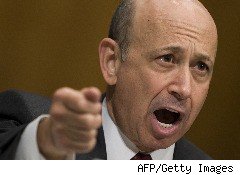 Goldman Sachs (GS) sure knows how to make a deal. Rumors had it that Goldman would have to shell out between $1 billion and $5 billion to settle Securities and Exchange Commission civil fraud charges over its Abacus synthetic collateralized debt obligation (CDO) transaction. But Goldman walked away with a mere $550 million payment.
Goldman Sachs (GS) sure knows how to make a deal. Rumors had it that Goldman would have to shell out between $1 billion and $5 billion to settle Securities and Exchange Commission civil fraud charges over its Abacus synthetic collateralized debt obligation (CDO) transaction. But Goldman walked away with a mere $550 million payment.
Here’s one way to put that into perspective: It’s just 8.9% of the $6.2 billion increase in Goldman’s market value on the day the deal was announced. And it’s an even smaller portion of the cash, backdoor, taxpayer-funded bailout Goldman was handed in 2008. And it’s a speck compared to the potential damages Goldman could have been assessed.
In the settlement, the firm admitted it was mistaken in telling investors that the CDOs in its Abacus deal were selected by an independent party — bond insurer ACA. It’s implicitly acknowledging that it should have disclosed John Paulson picked the CDOs so he could bet they’d become worthless — a bet on which he personally made $3.7 billion in 2007. If Goldman had gone to trial and lost, clearly the damage to its business could have been disastrous. (Criminal charges are still possible, so Goldman isn’t totally clear on Abacus yet.)
Fair Deal?
As a result of the settlement, Goldman will send $150 million to German bank IKB, and $100 million to Royal Bank of Scotland (RBS). RBS bought a Dutch bank that was backing ACA, which insured the Abacus deal, and suffered an $840 million loss on the CDO, 8.4 times more than the settlement it’s getting from Goldman.
What would have been a fair settlement with investors? If Goldman had been convicted of fraud, the maximum penalty could have been to reimburse Abacus fraud victims for their losses and to provide treble damages — three times the loss. The question of whether treble damages would apply depends on factors such as which fraud laws apply to the Abacus case.
So, Goldman could have paid RBS $3.4 billion and possibly another $640 million to IKB, but its actual payment to them was 3% for RBS and 23% for IKB of these potential damages. RBS may go after Goldman to make up the difference.
While not legally relevant, it’s worth noting that the $550 million SEC settlement represents only 4.3% of the $12.9 billion backdoor government bailout Goldman received when American International Group (AIG) passed its taxpayer-funded payment to Goldman, covering at 100 cents on the dollar the credit default swaps between AIG and Goldman. Note: Goldman makes sure it collects everything it thinks it’s owed when it comes time to collect, but it gets a lot stingier when it comes to paying those it owes money.
A Bigger Legal Whale for Goldman
The real concern for Goldman’s board is what other shoes have yet to drop. Sure, the firm could have marketed many other deals to investors with similarly fraudulent documentation. But odds are good that if the SEC had compelling evidence, it would have brought the cases forward already.
For my money, the biggest legal whale yet to be resolved is the insider trading allegations involving a Goldman board member leaking news of Warren Buffett’s September 2008 investment in Goldman to none other than Galleon Holding’s Raj Rajaratnam — the hedge fund grandee accused of trading on insider information. As I wrote on in April, that deal would expose corruption at the highest level of global finance and big company executive suites.
If Goldman can slip past that mess, it can really break out the bubbly. Until then, it should keep the corks in place — despite just sealing a deal that allows it make an essentially trivial payment for its admitted misdeed.


Leave a Reply